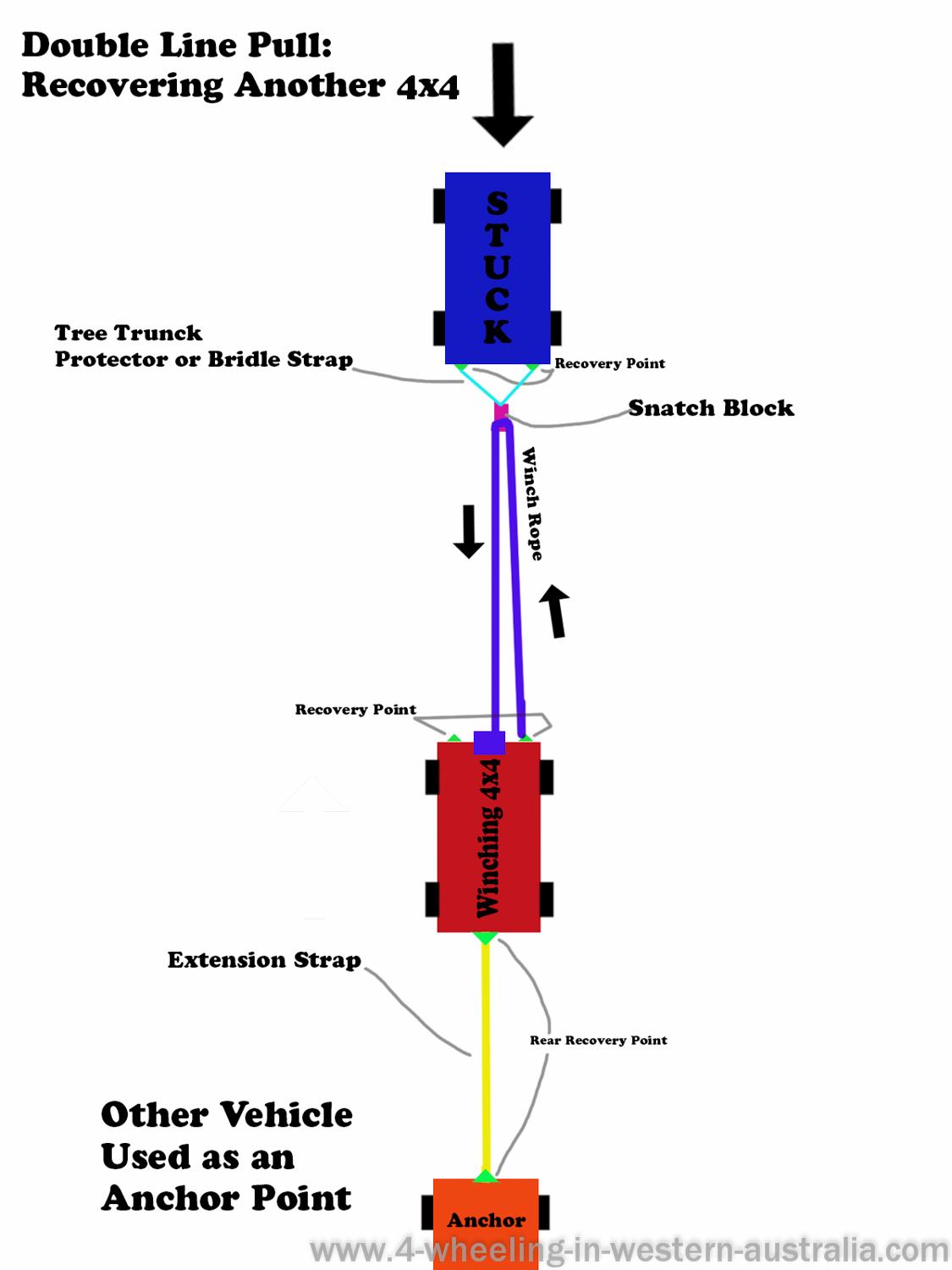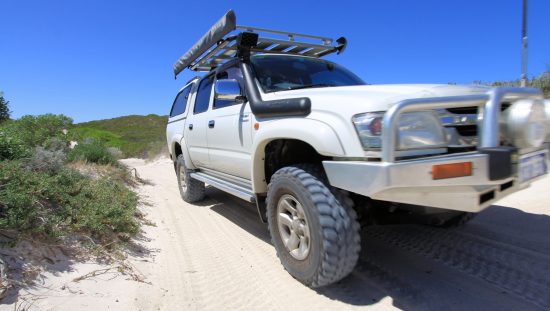
Advanced 4x4 winch rigging and full Winch kit.
Before reading this segment and attempting any of it you need to be confident with the general operations of the 4x4 winch and having a fully stocked winch kit.
Having done a few winch recoveries is highly recommended before trying to do any complex recoveries as getting it wrong can damage a vehicle or possible injure or cause death to someone.
The following advise/tips, guidelines and rigging are general only and will need to be adjusted to every situation as it will be different. Wherever it's just slightly or very different, adjustments will need to be made to any winch tips and rigging as there are too many factors involved.
Take good note of your environment and the vehicles involved, factor in the weight, type of recovery required, strength of anchor points (trees, rocks and rate recovery points), the direction, other vehicle aids (lockers), what to do after the recovery is done if other vehicles need to get past the same situation and all the other factors which are impossible to list.
Also knowing how every piece of a winch kit is used is a must!
Only once understanding & mastering general winching should you attempt the
following 4x4 winch rigging.
What is advanced winching?
Advanced winching is directional pulls, double line pull, triple line+ pull, winching backwards downhill and complex winching on tight tracks involving multiple directional pulling.
The main additional tools required here is of course a 4x4 winch and a good winch kit containing a snatch block or two, a tree trunk strap, extension strap, multiple anchor points and multiple recovery points! Without these not all advanced winching is safely possible.
Follow this link for General 4x4 winching, rigging and tips.
Directional pulls:
Some situations will require a directional winch pull, it could be due to many things, just to name a few reasons; avoiding a rut which is too deep, too close to an edge, the 4x4 is pointing in the wrong direction (happens very easily when tackling mud or on slippery hill climbs) or saving equipment wear and time by taking the path of less resistance.
A self recovery directional pull straight off the 4x4 winch to an anchor point is easily achieved if the direction of the angle is not too sharp and remember to turn the front wheels in the same direction.
If recovering another vehicle and an angle of 30 degrees or more is required, the stuck vehicle best have multiple recovery points (one on each side on both front and rear) to prevent vehicle damage from happening and will lessen the force required to recover the vehicle.
If needing to winch a vehicle forward on a 45 degree angle from the driver side but the only recovery point is on the passenger side it's really not possible in some situations, imagine the stranded vehicle is stuck on an angle leaning towards the driver side and a winch gets hooked to the only recovery point on the passenger side, it would risk pulling the stuck vehicle onto its side or even onto its roof!
Having multiple recovery points will help a lot!
See diagram below

4x4 Winch Double line pull:
Self recovery Double line 4x4 winch pull is when the winch rope is pulled out, put through a snatch block (snatch block is attached to an anchor point) and then pulled back/ "doubled back" to the vehicle and hooked up to a front recovery point so that the rope is now attached to the same vehicle twice (Attached by the winch and recovery point at the same time).
The 4x4 winch now almost doubles in pulling power!
A single line pull with a 4x4 winch is a fast and direct method when compared to a double line pull and if the winch is rated at 9000lbs of pulling this will be the maximum load limit.
If pulling close to the maximum limit (say 4x4 stuck in mud 8000lbs load due to sticky mud) the winch will be worked hard, also the more load the slower it will pull.
Take the same situation but with a double line pull; the vehicle weight combined with the sticky mud 8000lbs which is very close to the 9000lbs working load limit.
Rigging up a double line pull will almost double the pulling strength to just less than 18000lbs causing the winch to pull with ease dramatically reducing wear to the 4x4 winch.
Double line pull does mean twice the rope so there is more rope to be pulled in meaning it takes twice as long to winch the rope, however in the event of a single line pull close to the winches load limit a double line will still beat a single line pull in time as the winch will be very slow pulling in due to being near its maximum limit.
Winch Kit equipment used: Winch, Snatch block, Front/rear recovery points, possibly an extension strap, tree trunk protector/strap and multiple D shackles.
See diagram below

Recovering another vehicle using the double line pull is also possible; this would require the disabled vehicle to have two recovery points on the front or the rear of the vehicle in order to do safely.
To rig this up the end of a bridle strap or tree trunk protector is attached at each recovery points to even the load.
A winch block is then attached to the bridal/tree trunk strap which the winch rope from the recovering 4x4 is pull through and then doubling the winch rope back to the winching 4x4 (recovery 4x4), just like the standard double line pull. Only this time the instead of a tree at the snatch block end it’s the disabled vehicle requiring recovery.
Using the method of double line pull the winching vehicle will more than likely need a vehicle or anchor point behind it to stop it from being pulled towards the disabled vehicle.
See diagram below

A double line pull is used mainly for the following reasons:
To reduce the stress on the 4x4 winch
To enable the winch to pull nearly twice its working load
Triple line pull +:
Much like the double line pull only so much force is required a triple line pull is the only option also combining winch kits (Hopfully your mate has a full winch kit too)!
This type of winch recovery would rarely be required. To rig up the triple line pull will require 2 snatch blocks one on the tree and one on the front of the vehicle attached to 1 or sharing 2 front recovery points, 2 strong anchor points (2 tree trunk straps around the same tree or one on two trees near each other.
Winch Kit equipment used: Winch, 2 Snatch blocks, Front/rear recovery points, possibly an extension strap, 2 tree trunk protector/strap and multiple D shackles.
See diagram below

Recent Articles
-
Goodyear wrangler MTR
Jun 28, 24 10:27 PM
I have these on my defender 90 and my Dmax Ute. I get around 100,000 km out of them. I tried AT for one change and went back to the MTs. They are gol -
4x4 off road tracks 0 to 250 km from Perth
Nov 21, 23 07:40 PM
On this page we cover 4x4 off road tracks within a 250 km radius from Perth... -
4 Wheeling Around Jurien Bay.
Nov 21, 23 07:35 PM
Jurien Bay 4x4 tracks info and general information about the area...
- Home
- 4x4 Recovery
- Winch Kit
Leave Winch Kit And Go 4 Wheeling In Western Australia.





